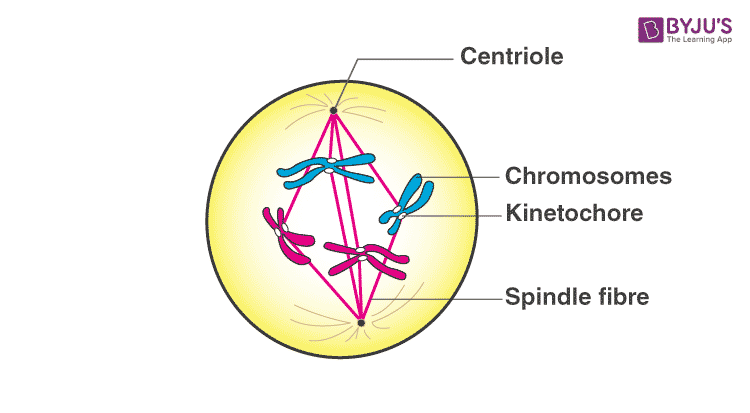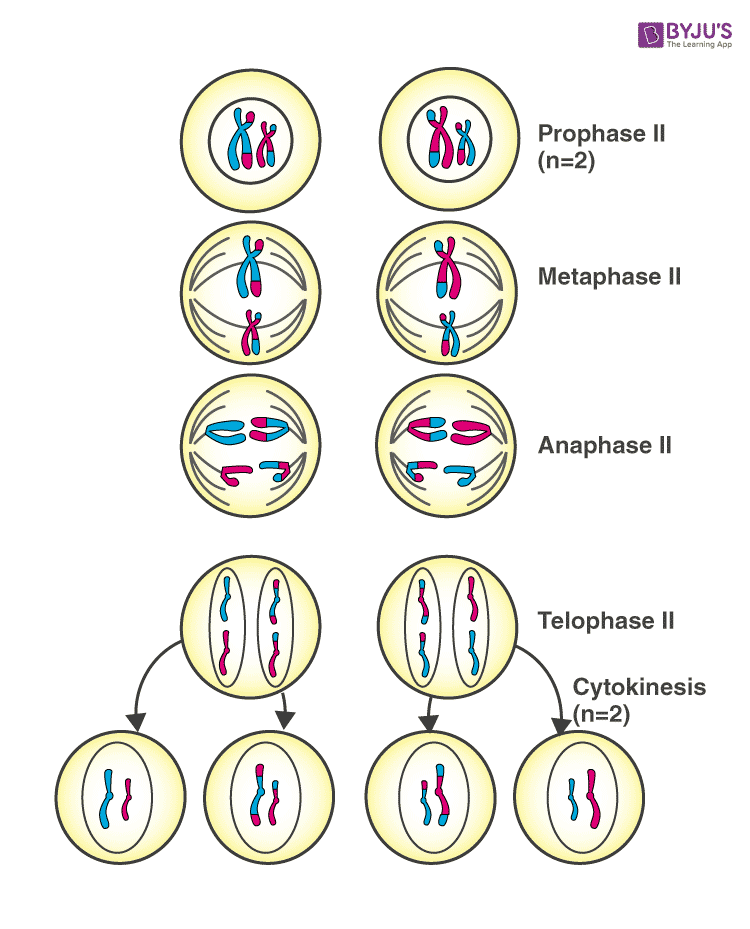NCERT Exemplar Solutions for Class 11 Biology Chapter 10 Cell Cycle and Cell Division serve you with the necessary understanding of the concepts covered in this chapter. Students who are planning to take medical and other biology-related courses in their higher studies need to understand the concepts of Cell Cycle and Cell Division clearly in order to avoid difficulty in the future.
Chapter 10, Cell Cycle and Cell Division, NCERT exemplar have answers to the questions in the NCERT exemplar book, consisting of MCQs, true or false questions, match the following questions, important diagrams and tables.
NCERT Exemplar Solutions for Class 11 Biology Chapter 10 Cell Cycle and Cell Division
Access NCERT Exemplar Solutions for Class 11 Biology Chapter 10
MULTIPLE CHOICE QUESTIONS
1. Meiosis in diploid organisms results in
a. Production of gametes
b. Reduction in the number of chromosomes
c. Introduction of variation
d. all of the above
Solution:
Option (d) is the answer.
2. At which stage of meiosis does the genetic constitution of gametes is
finally decided
a. Metaphase I
b. Anaphase II
c. Metaphase II
d. Anaphase I
Solution:
Option (d) is the answer.
3. Meiosis occurs in organisms during
a. Sexual reproduction
b. Vegetative reproduction
c. Both sexual and vegetative reproduction
d. None of the above
Solution:
Option (a) is the answer.
4. Mitosis is characterised by
a. Reduction division
b. Equal division
c. Both reduction and equal division
d. Pairing of homologous chromosomes
Solution:
Option (b) is the answer.
6. A bivalent of meiosis-I consists of
a. Two chromatids and one centromere
b. Two chromatids and two centromere
c. Four chromatids and two centromere
d. Four chromatids and four centromereSolution:
Option (c) is the answer.
7. Cells which are not dividing are likely to be at
a. G1
b. G2
c. Go
d. S phase
Solution:
Option (c) is the answer.
8. Which of the events listed below is not observed during mitosis?
a. Chromatin condensation
b. Movement of centrioles to opposite poles
c. The appearance of chromosomes with two chromatids joined together
at the centromere.
d. Crossing over
Solution:
Option (d) is the answer.
9. Identify the wrong statement about meiosis
a. The pairing of homologous chromosomes
b. Four haploid cells are formed
c. At the end of meiosis, the number of chromosomes is reduced to
half
d. Two-cycle of DNA replication occursSolution:
Option (d) is the answer.
10. Select the correct statement about G1 phase
a. The cell is metabolically inactive
b. DNA in the cell does not replicate
c. It is not a phase of synthesis of macromolecules
d. Cell stops growing
Solution:
Option (b) is the answer.
VERY SHORT ANSWER TYPE QUESTIONS
1. Between a prokaryote and a eukaryote, which cell has a shorter cell
division time?
Solution:
Prokaryotes take a shorter time for cell division.
2. Which of the phases of the cell cycle is of the longest duration?
Solution:
Interphase. In a 24-hour cell cycle, 23 hours are for I-phase and 1 hour for M phase.
3. Name a stain commonly used to colour chromosomes.
Solution:
To make the chromosomes visible, the cell is stained with Acetocarmine and mounted in acetocarmine only.
4. Which tissue of animals and plants exhibits meiosis?
Solution:
Germ cells present in the reproductive tract undergo meiosis to produce gametes.
5. Given that the average duplication time of E.coli is 20 minutes, how much time will two E.coli cells take to become 32 cells?
Solution:
2 →4 →8 →16 →32
It takes 80 mins.
6. Which part of the human body should one use to demonstrate stages in mitosis?
Solution:
Tissues near to the cheeks can be taken to demonstrate stages in mitosis.
7. What attributes does a chromatid require to be classified as a chromosome?
Solution:
When chromatids are attached to the centromere, it is termed as a chromosome.
8. The diagram shows a bivalent at prophase-I of meiosis. Which of the four chromatids can cross over?
Solution:

Sister chromatids of homologous chromosome
9. If the tissue has at a given time 1024 cells, how many cycles of mitosis had the original parental single-cell undergone?
Solution:
2x=1024
X=10
Therefore, the parent will undergo 10 rounds of mitosis.
10. An anther has 1200 pollen grains. How many pollen mother cells must have been there to produce them?
Solution:
1 pollen mother cell →4 pollen grain
Therefore, no. of PMC = 1200/4 = 300 pollen grains.
11. At what stage of the cell cycle does DNA synthesis take place?
Solution:
At the S-phase of the cell cycle, DNA synthesis takes place.
12. It is said that the one cycle of cell division in human cells (eukaryotic cells) takes 24 hours. Which phase of the cycle, do you think occupies the maximum part of the cell cycle?
Solution:
Interphase is the phase of the cycle that takes 23 hours out of 24 hours.
13. It is observed that heart cells do not exhibit cell division. Such cells do not divide further and exit ___________ phase to enter an inactive stage called ___________ of cell cycle. Fill in the blanks.
Solution:
G1 phase, G0 phase.
14. In which phase of meiosis is the following formed? Choose the answers from hint points given below.
a. Synaptonemal complex ____________________________
b. Recombination nodules ____________________________
c. Appearance/activation of ____________________________
enzyme recombinase
d. Termination of chiasmata _ ___________________________
e. Interkinesis ____________________________
f. Formation of dyad of cells _ ___________________________
Hints: 1) Zygotene, 2) Pachytene, 3) Pachytene, 4) Diakinesis, 5) After Telophase-I /before Meosis-II, 6) Telophase-I /After Meiosis-I.
Solution:
a. Zygotene
b. Zygotene
c. Pachytene
d. Diakinesis
e. After telophase I/before meiosis
f. After Telophase I/after meiosis I
SHORT ANSWER TYPE QUESTIONS
1. State the role of centrioles other than spindle formation.
Solution:
Centriole forms the microtubule and forms the basal body of flagella.
2. Mitochondria and plastids have their DNA (genetic material). What is known about their fate during nuclear division, like mitosis?
Solution:
DNA present in mitochondria in plastids is called the extrachromosomal DNA.
They are independent of the nuclear division of nuclear DNA. Hence, no effect of mitosis is seen on extrachromosomal DNA.
3. Label the diagram and also determine the stage at which this structure is visible.
Solution:

4. A cell has 32 chromosomes. It undergoes mitotic division. What will be the chromosome number (N) during metaphase? What would be the DNA content (C) during anaphase?
Solution:
Both N and C will be 32. This is because DNA is replicated during the S phase, after that it would remain the same during equational division.
5. While examining the mitotic stage in a tissue, one finds some cells with 16 chromosomes and some with 32 chromosomes. What possible reasons could you assign to this difference in chromosome number? Do you think cells with 16 chromosomes could have arisen from cells with 32 chromosomes or vice versa?
Solution:
The phenomenon of the existence of two types of chromosome no. in a different cell of the body is called mosaicism. This may arise due to the non-disjunction of chromosomes or lag of anaphase.
6. The following events occur during the various phases of the cell cycle, Name the phase against each of the events.
a. Disintegration of nuclear membrane _________________________
b. Appearance of nucleolus _________________________
c. Division of centromere _________________________
d. Replication of DNA _________________________
Solution:
a. Early Prophase
b. Late Telophase
c. Anaphase
d. S phase
7. Mitosis results in producing two cells which are similar to each other. What would be the consequence if each of the following irregularities occur during mitosis?
a. Nuclear membrane fails to disintegrate
b. Duplication of DNA does not occur
c. Centromeres do not divide
d. Cytokinesis does not occur
Solution:
a. Nuclear membrane fails to disintegrate, then the spindle fibre would not reach the chromosomes.
b. Duplication of DNA does not occur, then the whole cell cycle would get arrested and will enter an inactive stage called the G0 stag.
c. Centromeres do not divide- Sister chromatids would not split to opposite poles, and one daughter cell would get two sister chromatids, whereas the other will get none.
d. Cytokinesis does not occur- It will result in polyploidy.
8. Both unicellular and multicellular organisms undergo mitosis. What are the differences, if any, observed in the process between the two?
Solution:
In prokaryotes, amitosis takes place, the cell directly divides into two daughter cells. Whereas in multicellular organisms, proper steps of cell division occur; first the karyokinesis takes place then cytokinesis occurs.
9. Name the pathological condition when uncontrolled cell division occurs.
Solution:
This is called malignancy caused due to cancer.
10. Two key events take place, during S phase in animal cells, DNA replication and duplication of the centriole. In which parts of the cell do events occur?
Solution:
DNA replication occurs in the nucleus and centriole duplicates in the cytoplasm.
11. Comment on the statement – Meiosis enables the conservation of specific chromosome number of each species even though the process per se, results in a reduction of chromosome number.
Solution:
A diploid zygote is formed when the two haploid cells called gametes fused during fertilization. If meiosis is absent than two diploid gametes would be produced which will result in the formation of tetraploid zygote. To conserve the chromosome, number meiosis is very important.
12. Name a cell that is found arrested in diplotene stage for months and years. Comment in 2-3 lines how it completes the cell cycle?
Solution:
The oocyte of mammalian females gets arrested in the diplotene stage. The oocyte grows and forms secondary follicle and then it gets arrested at the diplotene stage. As the woman attains sexual maturity first, meiosis gets completed. Meiosis occurs one by one in the egg, which is released from the ovary.
13. How does cytokinesis in plant cells differ from that in animal cells?
Solution:
Cytokinesis in plants occurs by cell plate formation. Cell plate formation starts from the centre and grows to the periphery.
LONG ANSWER TYPE QUESTIONS
1. Comment on the statement – Telophase is reverse of prophase.
Solution:
In Prophase- Chromosome condenses. The nuclear membrane disintegrates. Organelles like mitochondria, endoplasmic reticulum, and Golgi apparatus disappears. Cells at the end of prophase do not show Golgi complexes, endoplasmic reticulum and nucleolus. The chromosome clusters will be surrounded by the nuclear envelope at the telophase stage.
2. What are the various stages of meiotic prophase-I? Enumerate the chromosomal events during each stage.
Solution:
Prophase I-
a. Leptotene stage:
• Nuclear membrane starts to disappear.
• Chromatin material starts condensing.
• Centriole reaches opposite poles.
• In some members of Liliaceae, chromosomes remain attached to the nuclear membrane–bouquet stage.
b. Zygotene:
• Pairing of homologous chromosomes start.
• To hold these homologous chromosomes a protein called synaptonemal complex develops.
c. Pachytene
• Biavalent [homologous chromosomes] or tetrad becomes visible.
• Crossing over takes place resulting in genetic recombination.
• The enzyme recombinase, for crossing over comes from the recombination nodule of the synaptonemal complex.
d. Diplotene
• Synoptenemal complex dissolves
• But homologous chromosomes are still held by an X-like structure called the chiasma.
• Chiasmata develops at the point of crossing over.
e. Diakinesis
• Terminalisation of chiasmata: Chiasmata starts opening in a zipper-like fashion towards the periphery
• Nuclear membrane and nucleolus nearly disappear.
3. Differentiate between the events of mitosis and meiosis.
Solution:
MITOSIS
1. Prophase will be short duration
2. Only a single metaphasis plate is formed during metaphase.
3. Sister chromatids tend to move opposite pole during anaphase
4. Cytokinesis occurs after mitosis
MEIOSIS
1. Prophase I is a long duration and prophase II is a short duration
2. Metaphase I – two metaphasic plates and Metaphase II is a single metaphasic.
3. Two homologous chromatids separate during anaphase I.
4. It doesn’t occur after meiosis I, occurs after meiosis II
4. Write a brief note on the following
a. Synaptonemal complex
b. Metaphase plate
Solution:
a. Synaptonemal complex
It is made up of protein formed between two homologous chromosomes. The complex formed during zygotene which is the substage of Prophase I. It contains a recombination nodule which consists of enzyme recombinase involved in crossing over.
b. Metaphase plate
The metaphase plate is the imaginary line which is formed in the centre of the cell during metaphase. The chromosomes will get close to the spindle fibres and align themselves on the plate. The movement of chromosomes towards the metaphase plate is called congression.
5. Write briefly the significance of mitosis and meiosis in a multicellular organism.
Solution:
Mitosis creates the cells necessary to add more mass to the body, as well as more cells to cope with the growth, such as new blood cells. In case of injury, mitosis is involved in the healing of the tissues. Meiosis also produces genetic variation by way of the process of recombination. It helps to conserve the no. of chromosomes in a species.
6. An organism has two pair of chromosomes (i.e., chromosome number = 4). Diagrammatically represent the chromosomal arrangement during different phases of meiosis-II.
Solution:

Cell cycle and cell division are a few different processes that form a part of your body. The tendency of two daughter cells to multiply from a single parent cell is termed Cell division. Prokaryotic cells rely on the process of binary fission, while Eukaryotic cells rely on the process of mitosis. The cell cycle can be defined as the events which take place during the process of cell division.
- Prophase – Prophase is the first stage of mitosis.
- Metaphase – The second stage of mitosis is metaphase, where sister chromatids are formed.
- Anaphase – The third stage of mitosis is anaphase, where the splitting of centromeres takes place, and the sister chromatids move to opposite poles.
- Telophase – The fourth stage in mitosis is telophase, where the chromosome cluster is covered with the nuclear envelope.
- Cycle 1 is called meiosis 1, and the second cycle is called meiosis 2.
| Also Access |
| NCERT Solutions for Class 11 Biology Chapter 10 |
| CBSE Notes for Class 11 Biology Chapter 10 |
BYJU’S provides you with Cell Cycle and Cell Division Class 11 videos, animations, exercises, and worksheets that help you to understand and memorise the concept and topics for a very long time. For NCERT solutions, exemplars, notes, books, study materials, tips and tricks etc., visit BYJU’S website or download BYJU’S – The Learning App.












Comments